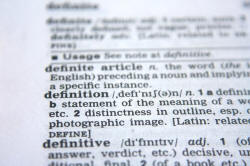Demonstratives: the essentials

 |
Definitions |
Demonstratives in English are a form of spatial or discourse
deixis. The term deixis is technical and
refers to pointing or referencing something which is not here, not
now and not me.
This is what that means:
- I want that one over there
Identifying something away from the speaker – spatial deixis - I like these
Identifying some items close to the speaker – spatial deixis - That morning I was working at
home
Identifying a time distant from now – temporal deixis - This evening, I'm staying at home
Identifying a time close to now – temporal deixis - ... and that's the problem
Identifying a previously mentioned item (anaphorically) – discourse deixis - You want to know? OK.
This is the problem ...
Identifying something to follow (cataphorically) – discourse deixis
There is a separate guide to deixis on this site, linked in the list below. If the foregoing or the following fails to make too much sense, refer to that for some background.
 |
Pronoun, adjective or determiner? |
Traditionally, and still in many grammars for learners, demonstratives are divided into those which stand for the noun (i.e., are pronouns) and those which describe or modify the noun. In the second case, we can use the term determiner to describe them or the older term, demonstrative adjective. So, for example, we get:
- I want that hat (demonstrative adjective or determiner modifying the noun hat)
- I want that (demonstrative pronoun replacing a noun)
- She likes those (demonstrative pronoun)
- She likes those people (demonstrative adjective or determiner)
and so on.
It is fairly simple to see, however, that the forms of the words are unchanging and their uses are very closely related. The analysis here, consequently, will focus on demonstratives and take their uses in turn, regardless of whether they are pronouns or determiners.
 |
Distance |
In most uses of demonstratives, there is, in English, a simple distinction:
- For things or time close to us we use this or these
- For things or time further away, we use that or those
So we get:
- At this time, I can't talk about it
- I couldn't talk about it at that time
- Pass me that
- She gave him this
- Those ones in the corner look best
- These ones on the table are too shabby
and so on.
Note here that many languages, such as Turkish and Japanese, make a distinction between things or times close to the speaker, things or times far from the speaker but close to the hearer and things or times far away from both the speaker and the hearer. Speakers of those languages may have problems selecting the right forms. English used to make these distinctions and vestiges remain in dialect and the unusual adverb yonder.
The reference can work either to something to follow or to something that has come before:

The term for referring back to something that has come before is
anaphoric reference.
The term for referring forward to something later in the text is
cataphoric reference.
 |
Pointing |
This is known as deixis. We use demonstratives to select items as in, e.g.:
- That is my daughter
- Those are the actors
- These are my friends
When the demonstrative is the subject of the sentence, it can refer to people or things:
- That is his mother
- Those are her books
But when the demonstrative is the pronoun object, it can only have impersonal reference and cannot be a replacement for a person:
- I explained that clearly to Mary
- *I explained the problem to that
 |
Discourse |
We can use this and that to refer not to things or time but to what has been said or will be said. For example,
- Listen. You are going to love this ....
- ... and that's why I was late home.
- ...so this explains why I'm late.
- ... and these are my only thoughts on the subject
- ... and those are all the reasons I don't want to marry you.
- These are my reasons for not voting this time ...
The demonstratives this and these can refer both forward and back (but usually forward) but that and those can only refer back.
 |
Exceptions |
Usually, the discussion of demonstratives ends here with only the consideration of this, that, these and those.
However, there is a small class of words and phrases which act in a very similar way and which can be taught as demonstrative pronouns because that is what they actually are. Here are the examples:
- John and Peter got married in the same year. The latter to Susan; the former to her sister.
- They both have opportunities and risks attached. We must be careful to take advantage of the one and avoid the other.
| Related guides | |
| deixis | this is a more technical guide to how English expresses not here, not now and not me |
| other pronouns | go here for more on pronouns vs. determiners and other indefinite and impersonal pronouns |
| cohesion | for more on how referencing holds language together |
